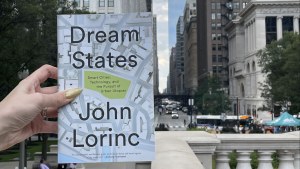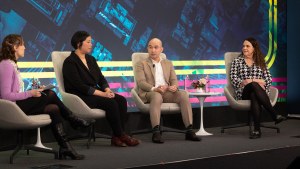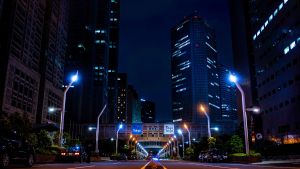New Technologies Transforming City Life: Dream or Reality?
 Play Podcast
Play Podcast
About the Episode
Can smart cities truly deliver on their promises of innovation and sustainability? On Deep Dish, author and winner of the Pattis Family Foundation Global Cities Book Award, John Lorinc joins host Brian Hanson to navigate the intersection of urban planning technology and ethical concerns in his book Dream States: Smart Cities, Technology, and the Pursuit of Urban Utopias.
This episode is brought to you by UL Solutions.
- Dream States: Smart Cities, Technology, and the Pursuit of Urban Utopia, John Lorinc, Coach House Books, August 23, 2022
- Your Data Were ‘Anonymized’? These Scientists Can Still Identify You, Gina Kolata, New York Times, July 23, 2019
[Brian Hanson: INTRO: This is Deep Dish on Global Affairs— going beyond the headlines on critical global issues.
I’m your host, Brian Hanson, with the Chicago Council on Global Affairs.
Today, we embark on a journey into the world of technology and cities, as laid out in John Lorinc's new book, "Dream States: Smart Cities, Technology, and the Pursuit of Urban Utopias." We'll explore the delicate balance between innovation and ethical considerations as technologies are developed to address urban challenges, and what is at stake in the choices that we make.
Yesterday the Chicago Council on Global Affairs announced that “Dream States” is the winner of the inaugural Pattis Family Foundation Global Cities Book Award, a new initiative from our Center on Global Cities that celebrates books that deepen our understanding of the role cities play in addressing critical global issues and urban policy.
This book is important and timely given the rapid development of artificial intelligence technologies from Chat GPT and beyond, which have burst into public awareness and have triggered intense debates over what these technologies will mean for our societies and our lives.
Indeed, the Council’s Pritzker Forum on Global Cities, this year is exploring this theme. The event is titled, Harnessing AI: Tools for Urban Leaders and will take place in Chicago November 13th-15th and will also be available online.
So, listeners let’s dive into the realm of urban dreams and the realities of the quest for a smarter, more connected futures.
Here with me to talk about his book is John Lornic the author of “Dream States”. We’ll be right with him after a quick word from today’s sponsor…
(UL SOLUTIONS AD BREAK)
We’re back with Deep Dish, speaking with John Lornic. John is a freelance journalist and editor who reports on urban affairs, politics, and technology.
A central feature of cities is that they concentrate lots of people in a very small space. Today so... 56 percent of the world's population currently lives in cities and it’s expected by 2050 some 7 and 10 people will live in cities. Yet, cities only comprise about 3 percent of the Earth's landmass. John says that these concentrated communities create both benefits and challenges for city living...]
John Lorinc: We come together in cities for all sorts of reasons, but cities are these kind of engines of innovation and culture and, just mixing of people from all different sorts of backgrounds and places. And so, they are incredibly vital places. At the same time, I mean, you have a lot of people living in, small areas, and so that produces all sorts of stresses, right? It's, you know, about housing, about transportation, and how do we get around cities, now we're very aware of the role that cities play in climate change, the role that cities could play in mitigating climate change. So, it's all sort of a big kind of bundle of, you know, seeming contradiction, but you know, I'm of the view that cities are generators of answers and, new ideas and new ways of solving problems. And so, I think it's a good thing that the world is becoming more urbanized.
Brian Hanson: And one of those new answers that emerged was this idea of a smart city, um, using technologies to address some of the challenges and drawing on some of the strengths that you just touched on. What does this term smart city mean?
John Lorinc: I'll just use the definition that I chose for “Dream States”, which is, it's basically a large family of technologies, primarily digital technologies that, you know, are intended to address the issues of city living, right? So, mobility, energy, public space, all of these things. And it's a very dynamic space. The smart city industry is worth hundreds of millions of dollars a year. The customers are primarily, you know, municipal, regional governments. And so that's, the kind of framework that I use.
Brian Hanson: And one of the things that's very fascinating about the book is you point out that technologies for centuries have been coming into cities in order to address challenges and make city life more livable and more fulfilling in terms of the smart city technology. Is there something that differentiates kind of the things that we call smart cities technologies from the kinds of technologies that came before?
John Lorinc: So, I'm going to choose a Chicago example. I mean, you have these great bridges that are across Chicago river, right? And bridges are kind of an assembly of. Different types of technology, their engineering and materials. And what a bridge does is it allows somebody to get from one shore to the other shore. It does one thing. And we know how to make bridges that do that one thing and not fall down. The difference with smart city technology. Like your phone, like your laptop, digital technologies do many different things. And even when you're acquiring a type of smart city technology that's sort of intended to, let's say, make, traffic lights work more efficiently, they can still do many, many things. And so that is fundamentally, in my view, the difference between more traditional city oriented technologies, which have more carefully delineated and smart city technologies which can be configured endlessly just like your phone and just like any other digital device you use.
Brian Hanson: What are some of the examples of, you know, successful, technologies that have been introduced in this smart cities kind of movement?
John Lorinc: When I was doing the book, I kind of used this informal guidelines, to analyze different types of smart city technologies. There are technologies that are directed at infrastructure and systems and the others that are directed at people. The types of technologies that focus on infrastructure and on urban systems, I find those are where you find the most interesting and positive examples. I think that the one that I find most compelling is smart grids, right? So, we're living in this world where we need to figure out how to produce energy without burning fossil fuels and smart grids are really an essential part of that Like how do we manage the electricity system as we transition to an electric economy? And that's a very complicated task because traditionally our energy sources were you had a power plant, it burned coal or natural gas or whatever, produced that flow to your house or your office or wherever. now we have a much more decentralized system, it's much more difficult to manage, and so there's a whole family of smart grid technologies that are emerging to help with that transition. Incredibly important, very positive. there are a bunch of those that are sort of climate focused, which I find are innovative, they're interesting, and they're not kind of problematic from a point of view of privacy or security and so on.
Brian Hanson: I think one of the things that you write about really well in the book is this idea of bringing together large amounts of information from different kinds of sources and using technology to be able to interpret that data, predict what the city needs and to be able to adjust things and you mentioned a maximalist vision of kind of what might be possible with these kinds of technologies. Can you give us a sense of what was that vision and what was anticipated that might be possible?
John Lorinc: Well, I think that vision was really on display in the Sidewalk Labs project that was proposed for Toronto, which we can talk about later. But it's this idea that if you put as many sensors in public space as possible and collect as much data as possible, and when I say data, I'm not talking about like statistics. I'm talking about like signals, you know, cell phone signals. It's, you know, the signals picked up by the number of bodies moving across an intersection, that kind of thing. And you sort of see that big system of sensors as a kind of a massive listening device that sort of figures out what's happening in the city. And then you can kind of slice and dice that data and say, okay, well, we could, apply, the insights and the predictions that we can make from that data to help with traffic flow or to help with the sort of processing stormwater and managing stormwater and so on. That's the maximalist vision, right? The more you can gather, the better your predictive capabilities will be.
Brian Hanson: In this world, some cities embrace this more broadly than others. We're going to talk in more detail about the Toronto Sidewalk Labs, but what are other cities around the world that really embraced this vision and who's been driving kind of this movement for adoption of these technologies?
John Lorinc: So, you know, examples that come to mind right away, uh, Amsterdam, Barcelona, there's a sort of a new development at the edge of Seoul in South Korea, called Songdo. These are all places where there's been a lot of activity around smart cities, and for my research, I would say that in some cases, like Songdo, which was a kind of a new development on a derelict industrial site. The driver is really, large tech companies, that saw an opportunity to marry their technology and their hardware to large scale development and so, it's a kind of a top down approach. It was sexy at a certain point, and it's definitely very maximalist. In other places, you know, Barcelona and Amsterdam are good examples. You have a more sort of bottom up approach where the technology is used discreetly in response to known problems in the urban space. And it's also, and this is very true in Barcelona, that the technology is deployed with eyes wide open, right? So, there's a great deal of democratic scrutiny about the implications associated with deploying certain types of technology in public space. And that's a more bottom up approach. Now, I mean, governments are involved in both cases. It's less a case of the tail wagging the dog, and when you have, like, large technology companies that are advancing this, you have to sort of ask yourself whether these are problems being invented for a technology company to come in and solve, or if it's the other way around.
Brian Hanson: That is a great transition to what we've referred to a few times, which is this huge experiment that was launched, in Toronto which was called, Sidewalk Labs. Can you share what this project was? What was it intended to do? Kind of, what was the vision?
John Lorinc: So, Sidewalk Labs was a joint venture between, sort of Google Alphabet and a development startup that was headed up by Dan Doktoroff, who was, formerly, the deputy mayor of New York City and worked for Michael Bloomberg. The idea was to kind of bring together, like real estate development and technology and create this kind of smart city. And the model for that is Hudson Yards in New York, which is, you know, that's what Dan Doctoroff was responsible for, among many other things. It also sort of emerged, O'Kane, who's a reporter for the Toronto Globe and Mail, discovered from this kind of, fantasy that Larry Page had. Larry Page was the co founder of Google to create this sort of smart city, like this totally wired city, and in fact, put it under a giant geodesic dome or something like that. So, they kind of ended up finding this big, swath of derelict industrial space in the eastern end of Toronto's waterfront. And began developing a plan for how to build that out, build out this area, and really sort of fit it out with as much digital technology as possible, right? So, the infrastructure, the wires, the sensors, the whole works. And then, put that in buildings that were going to be made out of tall timber. So, the operative word in the company's name is labs, right? It was going to be a sort of an experimental place where you were going to see what you could come up with in terms of, the new types of technologies. And then Google Alphabet could market those around the world. It kind of arrived with a big splash in 2017. It was a source of sustained controversy and pushback over two and a half years. And then in April of 2020, about a month after the pandemic was officially declared, Sidewalk decided to pull the plug on it. And there were a number of reasons behind that, but Google has, sort of, a corporate ethos of the fast fail, right? You try something, it doesn't work out. You don't sort of see if you could nurse it along, but you just sort of pull the plug and bits and pieces of Sidewalk have moved into other parts of Google's empire, uh, but Sidewalk no longer exists.
Brian Hanson: So, think one of the things, as you point out, throughout your book is some of the limitations that Sidewalk Labs, revealed, and some of the challenges, for bringing in this kind of approach, which you've just described, is a very top down, kind of, we've got a vision that we are going to land, here. It's going to do great things. Trust us. It's all be fine. Can you talk about some of the controversies and some of the things that we've learned from that experiment?
John Lorinc: Well, I'll begin with a high level one, and this is something I was trying to get at with the book, which is that there's a very old instinct among human beings to sort of envision utopian societies and utopian cities, and, you go back to Thomas More, you go back to Le Corbusier, Frank Lloyd Wright, a thing that we do, and I understand why we do that, right, because cities can be very challenging places to live. That inclination exists, and it exists in the present tense and when I was covering Sidewalk Labs, I really saw that this was a company that was trying to advance a highly utopian idea about how cities should work. The old saying, right, the devils in the details. And the fact that, there was going to be this enormous amount of collection of information and data on people. And so, you think, well, is that a good thing or is that a bad thing? And, and we know that we give up a huge amount of data for free all the time, right? You know, we use our cell phones, we use Google Maps, and we're constantly sort of putting information about ourselves into the ether. And what I would say was an important point of differentiation here is that this was done in the name of city building. And so, it was a city, it was going to be, run by sort of some kind of Quango or quasi public entity. The municipality had a piece of it. Then you have to ask questions about the democratic role of municipalities in the smart city movement, right? You know, to what extent are they enablers of technology that's potentially quite intrusive, or are they the guarantors of privacy and, the ability, you know, this, this is an old thing with cities, you know, you could be anonymous in a city, you could disappear in a city and so this was the one of the big tensions in the controversy around Sidewalk Labs and the company could not really properly address it, because the fundamental premise of what they wanted to do was to collect information. And that's still all problematic.
Brian Hanson: Yeah. Why is that problematic?
John Lorinc: Well, there's this notion of anonymizing. data, right? So, when you use your cell phone in public space, there's a signal that goes to the cell phone towers. That's not, you know, this is my telephone and anonymized. We live in a world where there are a lot of people who know how to de anonymize data. And there was a great piece that I came across when I was researching the book that was published in the New York Times, where they kind of worked backwards from an image captured by a closed circuit camera on one guy walking through Bryant Park in New York. And using deanonymizing techniques, we're able to sort of not only identify him, but figure out where he worked, you know, what he did, why he was there. And it's like, okay, well, you know, that's not that great. So, the technology is always in advance of public regulation, and I think that a lot of the critics in Toronto saw the big gap between those two things.
Brian Hanson: And I think one of the things is really interesting in the examples that you provide in the book is it's not only these large scale kind of totalizing projects like sidewalk labs, but you tell a great story about what happened in San Diego with what started as a pretty simple sounding project of just replacing streetlights so that they would be more efficient, use less energy and all. Can you talk about what happened there and why it turned into something a lot bigger than just, energy efficiency and streetlights?
John Lorinc: Yeah, so the municipality in San Diego, they wanted to replace streetlights with smart lights, right? And smart streetlights have LED bulbs, they can be controlled remotely. and as it turns out, General Electric, is headquartered in San Diego, was you know, producing some, like a new type of, smart streetlight that it wanted to sell around the world, and they did a deal with the city of San Diego to buy thousands of them. And, you know, coming back to what we talked about a little bit earlier, these streetlights had multiple functions. They were capable of many things, not just LED lights, but they had some onboard sensors that could ostensibly, determine, you know, how much traffic there was in a bike lane. What the street parking situation was and, you know, seemingly pretty benign stuff, right? But they also had ShotSpotter, which is, this technology that's designed to identify gunshots. They had a video camera on board, they had a microphone on board. And so, a bunch of these were installed, and then lone behold, it turned out that the police department was using them for investigative purposes. And using them for crime scene analysis. And, holding on to the tapes, the video that was on board on these things. And there was a movement of people in San Diego who were pretty upset about this. Um, these, smart lights seemed to be, popping up in, you know, in areas where there were a lot of African Americans, Hispanics, Asian Americans, and there was a concern about surveillance, so it produced an enormous backlash to the extent, to such an extent that eventually, the city had to pull the plug on these smart streetlights, which as a little sidebar was not that easy to do because they were really embedded in the city's infrastructure. There was a kind of an interesting, coda to this story, which is that the city council, took a lot of flack about this, and they eventually decided that what they needed to do was create a sort of a public accountability mechanism, you know, includes some citizens to scrutinize this kind of technology before it goes in and really sort of understand what they're committing to. And I think that there are examples of this in other places that this accountability structure in New York City has been doing it with AI, Barcelona has done a lot of it. And I think that it was a good news story as the end of a pretty difficult kind of narrative for San Diego.
Brian Hanson: So, one of the other things that I think you do a tremendously good job of in the book is laying out the interface between technologies and people. And you've got this great quote in the book, you know, the utopian fantasy that cities are potentially knowable. Thanks to omniscient technologies that purport to play a role of Oracle, predicting the future and all of its granularity and ordering up the necessary course corrections along the way. That sounds great. I want to live in that world. Don't I? But you point out that this interaction between these technologies and people making millions of decisions every day often doesn't go according to plan. Can you lay out a little bit, what are those tensions between the ideas driving the technologies and the way they play out in really complex urban environments?
John Lorinc: Well, I think that we have to be modest about what we believe computers are capable of predicting and, I mean, I finished the book before Chat GPT 4 was released to the public, but we see that with the way that this technology, this large language processing can come up with very bizarre answers. And if you think about a city like Chicago or Toronto, I mean, there's 3 million people, and everybody is doing their thing during the day. There's so many permutations and variables, like in essentially an infinite number of different things that are happening. And to assume that you could gather enough information to predict what the next thing that's going to happen is, you know, there's a bit of hubris around that. And there are some really great examples in the not too distant past about why we have to be humble in the face of the law intended of unintended consequences. So, you know, the Robert Moses and the West Side Highway believe…
Brian Hanson: In New York City?
John Lorinc: In New York City, you know, it was clogged the moment they opened it, right? With highways, there's this phenomenon of induced congestion. So, you think, okay, well, we're going to build something that will allow people to move faster. And in fact, it allows people to move much slower. And that's an example of predicting something, and then marshaling technology in this case, you know, elevated highway. Civil engineering, and then figuring out that it's not actually the right thing to do. and then conversely, you know, New York City, when Michael Bloomberg was the mayor, he had this Department of Transportation Commissioner, Jeanette Senecan, and she kind of went to, the mayor and said, okay, well, let's reduce street capacity. Let's add bike lanes. Let's add public plazas and see what happens. And it actually produced none of the apocalyptic versions of, uh, what, some people feared in terms of traffic and it sort of revitalized public spaces. And I think that these are kind of lessons that we need to think about when we use these smart city technologies. And this is why, when I look at these, is that if you have guardrails around them, if you're not too ambitious about what you want them to do, but they're there to fix this very specific problem. That's cool. That's, that's a good thing. But if the idea is that they're going to create this big maximalist vision of the city as you describe it, it's not going to go the right way.
Brian Hanson: So, think one of the reasons that your book is so timely is that we're on the beginning stages of the public being aware of, artificial intelligence and its ability, you know, with Chat GPT, becoming in the public spotlight and all. You know, I think your book, as I was reading it, offers some real lessons for how to think about this development and how we can prepare how city leaders, how citizens, how even the private sector can prepare what to do to help create better outcomes and to avoid some of the unintended consequences and, other really negative outcomes that have in society. What would you emphasize as the most important things that we should carry in mind as we enter in this new era of technologies?
John Lorinc: Well, I think critical thinking and critical thinking in a public forum, right? So, cities are a great place to do that. I do think that we have an uncritical, abrasive digital technology and I could talk for the rest of the day about the sort of negative outcomes, of digital technology, but in the context of cities, because they're the places where developed industrial economies like Canada and the United States, you know, 80 percent of us live in cities, right? That, an aggressive deployment of digital technologies, through the channel of local government or regional government can create big problems. I mean, create big solutions too. And I think that it's important to debate those and kind of be aware of the fact that when we release technology into the world, it does all sorts of things. It does many great things, many great things. These are very powerful tools and that, to my mind, is the big learning and the cities that have done well with smart city technologies are the ones that aren't just sort of saying, yes, this is going to be great. It's going to solve all your problems. They kind of say, okay, well, this is interesting, let's think about how we can use it, let's think if there are other ways of solving this problem that don't necessarily involve digital technology, you know, let's think about creating public accountability mechanisms that allow people to sort of say, okay, well, is this going to help my life? Is it going to make things more complicated? That's the big learning.
Brian Hanson: And one of the things I appreciate about the book is that it's not a negative book about technology, right? I think you do a great job of showing the ways in which technology really has improved life in the city and its importance and the importance of us continuing to, use the tools that make the most sense. So as we close. You know, there are a lot of people who are listening to this who live in cities, who are going to be affected by these technologies as they continue to roll out, and what should they pay attention to?
John Lorinc: Well, look, it’s never a wrong thing to encourage people to become more engaged in what local government does. And in particular because local government does collect a huge amount of information about people and the way they move around and what they do. And I think just getting into the habit of mind of, being a bit critical in terms of you know, how you approach new technologies. and this is a big ask, because we're constantly bombarded with different types of technologies and some of them are incredibly convenient. I mean, does anybody mourn the loss of those maps that you have to sort of fold and refold and you know, your partner is sitting in the front seats and you're trying to read it at the same time. Nobody mourns the loss of that, right? This is what I try to say in the book, and this is what I say in Publicly, I talk about the book is there are lots of benefits and then there are also lots of things that we have to think, carefully about. And the great example to my mind, in the very present tense is about the impact of these Big AI tools on education and on learning and how does an activity that really is very old, having somebody teach and engage students and young people in the work of learning the world. If we're inserting technology in the middle of that, you know, we have to really be sure of what we're doing and more conversation about that is always good.
Brian Hanson: John Lorinc author of “Dream States: Smart Cities, Technology, and the Pursuit of Urban Utopias”, which is the winner of the Pattis Family Foundation Global Cities Book Award -- I want to thank you so much for giving us such a thought-provoking exploration of the role of technologies in cities and how they are going to shape our future. And I really encourage all our listeners to pick up a copy of "Dream States". Thanks so much for being here, John.
John Lorinc: Thanks so much for your interest, Brian.
Brian Hanson: I also want to remind listeners that the Council will be hosting the Pritzker Forum on Global Cities, which is focusing on Harnessing AI Tools for Urban Leaders, Nov 13-15, both in person and online. More information on the Pritzker Forum can be found on the Council’s website: globalaffairs.org or by clicking the link in the show notes.
[Brian Hanson: OUTRO: And thank you for tuning in to this episode of Deep Dish!
A reminder that we want to hear more from you, our listeners. So, send us an email or, better yet, a voice memo, to deepdish@globalaffairs.org -- You can suggest issues you’d like us to cover, guests you’d love to hear from, or you can just let us know how you think we’re doing.
And if you are looking for more Deep Dish in your podcast diet? Tap the “follow” button in your podcast app so you get each new episode as it’s released. If you think you know someone who would like today's episode, please "share" it with them!
As a reminder, the opinions you heard belong to the people who expressed them and not the Chicago Council on Global Affairs. This episode is produced and edited by Kyra Dahring and mixed by Frank McKearn from Aphorism Productions.
Thank you for listening. I’m Brian Hanson and we’ll be back next week with another slice of Deep Dish.]




Related Content
 Global Cities
Global Cities
With AI set to reshape the world, "Dream States" offers a timely and comprehensive analysis of the challenges and opportunities of smart city technology.
 Global Cities
Global Cities
Cities have been called bastions of democracy, but authoritarian leaders across the globe are articulating their own visions for the future of urban spaces.
 Global Cities
Global Cities
City leaders must ensure full transparency and public control of data and infrastructure when partnering with tech vendors on smart city solutions.

